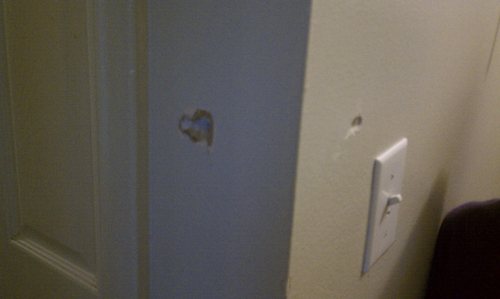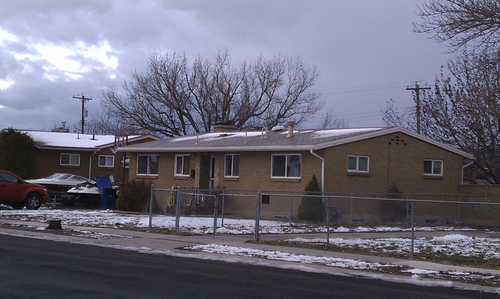This is an archived article that was published on sltrib.com in 2013, and information in the article may be outdated. It is provided only for personal research purposes and may not be reprinted.
It was over in 90 seconds.
That's how long it took for a rookie West Valley City police officer to fatally shoot 21-year-old Brandon Eric Chief in 2010 after arriving at the young man's home in response to a 911 call about a domestic dispute.
What exactly transpired inside the home — including whether Brandon Chief was shot first in the chest or the back — continues to be debated in a federal lawsuit as U.S. District Judge Ted Stewart weighs whether to allow the wrongful-death lawsuit filed by Frank and Etta Chief, Brandon's parents, to move forward to trial.
The shooting of Brandon Chief received little attention compared to the shooting two years later of Danielle Willard by two West Valley City undercover detectives. And Salt Lake County Attorney Sim Gill came to a far quicker decision about the Chief shooting. In January 2011, about a month after it occurred, Gill found Office Levi Lloyd was justified in shooting Brandon Chief. It took Gill nine months to determine the Willard shooting was not justified (see box).
R. Todd Macfarlane, an attorney representing the Chiefs, argues that Lloyd, who had been on the force just two months, used excessive force when he fired four shots at Chief on the night of Dec. 17, 2010. The Chiefs believe evidence shows their son was shot first in the back, as he walked away from the officer down a narrow hallway toward his bedroom.
They also claim policies that govern police response in domestic violence situations, which require that an arrest be made or a citation issued when an officer has probable cause to support an assault allegation, and an unwritten "21-feet rule" resulted in the deadly confrontation.
According to the rule, known as the Tueller Drill and offered in a mandatory course at the Utah Peace Officer Standards and Training program, more than 50 percent of the time an individual wielding an "edged" weapon is able to stab or slice an officer before he or she can draw a firearm if the distance between them is 21 feet or less.
Neither side disputes that those elements — a domestic fight, the distance between Lloyd and Brandon Chief inside a hallway in the Chief's home — were in play that night. But they disagree on whether the shooting was justified.
—
A family fight •The tragic chain of events began as Brandon Chief drove his 13-year-old niece to her basketball practice, according to an investigative report filed in the case. His vehicle got a flat tire and he stopped to fix it. The two began to argue after he got back in the car.
Brandon Chief, who had been drinking alcohol, grabbed his niece's head at some point and slammed it into the side of the car door, the report says. He stopped the vehicle and pulled his niece out and onto the ground, but she was able to get back into car. They then drove back to the Chiefs' home, where the fight continued.
Brandon Chief became infuriated after his niece smashed his bottle of alcohol on the ground and chased her into the home, where he threw her down and slammed her head repeatedly on the floor, according to the report. He then began damaging furniture and tossing household items, breaking several windows in the process.
At that point, the niece left the home and called 911, telling a police dispatcher her uncle had beat her up and was now fighting with his father. As Lloyd, the primary responding officer, and two other officers made their way to the home, they were told over the police radio that Brandon Chief had a "long history" and owned a rifle.
Brandon Chief's criminal history dated at least to 2007 and mostly consisted of misdemeanor shoplifting and intoxication offenses. At the time of the shooting, he was on probation for misdemeanor intoxication and being a restricted person in possession of firearm, apparently for a rifle found in his truck during a traffic stop.
Once the officers arrived, they found the "extremely emotional" niece outside the home and could see she had been assaulted and was bleeding from an ear. They paused only seconds to ask whether Brandon Chief was in the home. The report says the girl gave them permission to enter the home, which the Chiefs dispute.
Lloyd, who had been on the force only two months, according to Macfarlane, led the way.
—
The shooting •As Lloyd entered the home, he could see Frank Chief sitting in a living room at the back of the home and began walking toward him. That's when the officer encountered Brandon Chief at the intersection of two hallways.
The young man, who had been moving toward Lloyd, turned and began walking away. Lloyd shouted at Brandon Chief, identifying himself as a police officer and telling him to come speak with him. Brandon Chief, amid a stream of expletives, told the officer to get back.
In a deposition, a second officer said he had a "millisecond" view of Brandon Chief as he walked away from the officers and down the hallway. From that point on, no one else in the home could see Brandon Chief.
According to court documents, Lloyd says that as he shouted, the young man began to turn around, lifting his shirt as he did so, and then brandished a kitchen paring knife. From then on, Lloyd said in a deposition, the pair were always face-to-face.
Lloyd backed up, told the young man to drop the knife and shouted, "Whoa, whoa, he's got a knife." Lloyd says he fired four shots — the first of which hit a wall — as Brandon Chief continued moving toward him, aiming for his chest. The pair were between six inches and three feet apart, according to forensic evidence.
After being shot, Brandon Chief walked into view of the other officers, one of whom shot him with a Taser. He was pronounced dead later at a hospital. An autopsy showed Brandon Chief was shot twice in the chestand once in the back.
Experts who reviewed the case for the city and the Chiefs came to different conclusions about the position of Brandon Chief's body during the fatal confrontation — whether Brandon Chief was facing the officer or in the process of turning toward or away from Lloyd — and whether it is possible to determine the sequence of the shots.
—
The court case • Macfarlane said there is no evidence that Brandon Chief attempted to stab or lunge at Lloyd or threaten to do so, and contends he had his back to the officer when Lloyd fired the first shot and was struck twice more as he turned toward the officer. No firearms were found in the home.
"Another, more experienced officer might have operated differently than Officer Lloyd did," Macfarlane told Stewart in a recent hearing.
Heather S. White, an attorney representing West Valley City, its police department and three officers named as defendants, says Lloyd had no option but to fire at Brandon Chief during their confrontation in the narrow, short hallway inside the home.
"That officer is justified in believing his life, the lives of the officers behind him, the lives of the girls outside, were in danger," White told Stewart.
The officer's reaction was based on the threat posed by Brandon Chief, not the distance between them, White said. The city's evidence shows Brandon Chief was struck first in the chest, then side and finally the back, she said.
R. Robert Tressel, a criminal investigator in Georgia hired by the Chiefs to review the case, said Lloyd and the other officers placed themselves in jeopardy by not gathering critical information — they did not know, for instance, where Brandon Chief was or if he was armed — or by trying to defuse the situation before entering the home.
"We have to protect the people that are inside the house, and we also have to protect our suspect," Tressel said, speaking generally about law enforcement practice. "All of our attempts are to avoid the use of lethal force."
In his review of the case, Kenneth R. Wallentine, law enforcement chief for the Utah Attorney General's Office, said any "reasonable and well-trained officer would immediately prepare to use defensive deadly force in the face of an assailant advancing with a knife."
Lloyd was equipped with other weapons — including a Taser, baton and pepper spray — but they were not viable options, Wallentine said in his report.
"The officers did not have the benefit of what is now known in hindsight, nor does anyone know what Chief would have done if left unchallenged in his rage," he said.
Twitter: @Brooke4Trib —
Two shootings, two years apart, with different outcomes
While Salt Lake County District Attorney Sim Gill determined in January 2011 that a West Valley City officer was justified in shooting Brandon Eric Chief, he came to the opposite conclusion in the shooting death of Danielle Willard.
Willard was fatally shot on Nov. 2, 2012, as she sat in her vehicle in front of an apartment complex in West Valley City. Two undercover officers approached Willard's vehicle because they believed she had just engaged in a drug transaction.
One officer knocked on the driver-side window of Willard's car, identified himself as an officer and demanded she open the car door. When Willard did not do as instructed, the officer pulled out his gun and pointed it at her.
Willard, 21, still did not open her door, according to the officers. One of them then began walking to his vehicle to retrieve an object to use to smash Willard's car window. At that point, the officers said Willard put her vehicle in reverse. One officer said he fired at her because he feared he was about to be run over; the other also fired his weapon.
Gill determined in that case that the officers' version of events did not match the physical evidence and that use of force was not appropriate.
Brooke Adams











